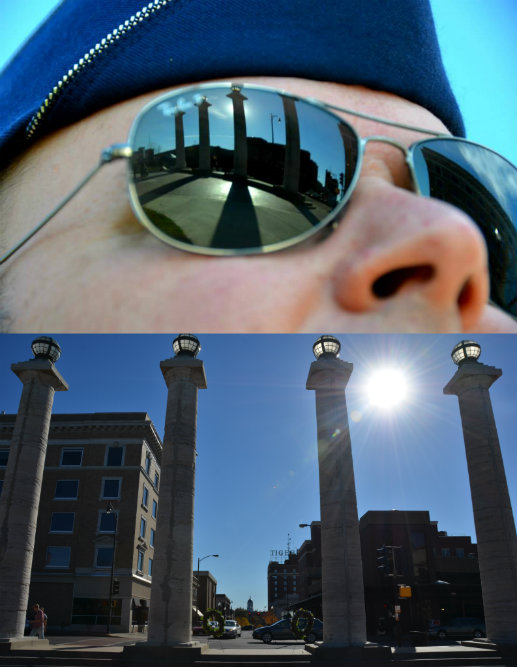As the largest city within the region, Columbia has always enjoyed the progressive nature of the University of Missouri-Columbia, the fruits of entrepreneurial businesses and the labor force of both the city’s residents and the surrounding communities.
The history of Columbia, is one for which any resident should be proud, and mindful of. The accomplishments and steps Columbia has taken forward from a small town, small city, to sizeable metro area with the city at the center, have been successful thus far.
No longer are we simply a point halfway between Kansas City and St. Louis, where the University of Missouri happens to reside. Instead, with a city population now well above 100,000 the community once known simply for the universities within it, has grown to something more.
Now, while perhaps a good portion of the growth we experience is because of the colleges within the city limits, it cannot be denied that the city is growing and at a fast rate. The truth will soon become that Columbia will become a city with colleges, rather than the college town it has been in the past, and it is our responsibility to recognize and adapt to these changes with a full embrace. It is often said that if a society is not growing, it is shrinking and the same goes for cities.
Growth is a blessing to any sized community, but given the opportunity to emerge from a big town, to sizeable city, is rarely afforded to any population and is one Columbia should embrace like all the other changes we have so far encountered and accommodated.
This transition, however, is one that is not faced only internally, but one that will take shape in a literal fashion, through the refurbishment and upward growth of the city’s downtown district, or some area in which the affluence and progress of the city can be shown. While the nostalgia of the city’s past, and the unique aspects of this city flourishes within the area directly south of UMC’s campus, the time has come to reconsider how we treat the district.
According to my calculations, the daytime population of Columbia is now around 143,000 people, an addition of roughly 37,000 people when it was calculated in 2000, that is growth that does not include the students of universities, an additional 49,563 people. All together, including those who commute to Columbia, go to school here and are permanent residents, the population of Columbia on any given day nine months out of the year is 192,196 people, nearly an addition of half of our stable population within city limits.
Perhaps to put things into perspective, this calculation is greater than the separate total stable populations of Salt Lake City, Utah and Tallahassee, Fla. Both of these cities, though truly larger, but not by much, have multiple buildings exceeding twenty stories or higher. Recently, Columbia has been approached by an architecture firm which wishes to build a 24-story apartment building, which was faced with both opposition and understanding acceptance. However, it has been recently discovered that the city’s current infrastructure does not support, not only such a building, but anymore renovation and construction at this time.
The city council voted in a five to two decision that the city would not support a tax on sales to help pay for the necessary improvements needed to accommodate the building projects around the district. Many residents, for one reason or another, say it should be the job of developers to pay for the multi-million dollar improvements to the infrastructure. However, while I reserve serious judgement on those who stifle progress, the truth is this attention shows the greater world Columbia is more than a town, which it now is whether they like it or not.
Honestly, the question doesn’t have to be, “do we or do we not want to build huge buildings and crowd our streets and quaint private businesses?” but rather, “do we want to continue to thrive as a community, and attract the business and interest of people that will inevitably promote the growth of Columbia?” After all, the truth is that the citizens and leaders of this community cannot afford to turn their collective noses up toward growth, because these are opportunities allow the city to monitor change and regulate and plan to become larger. While it can be agreed that The District of Columbia, a play on words that took me a while, too, will grow, maybe not all the city’s growth must occur in that one location. While some buildings must go up for the sake of accommodating more people and business, soon large companies such as IBM has recently done, will be interested in incorporating themselves into the city’s large labor force, while hopefully expanding it, as well.
Instead, the city should consider, seeing that it may not be willing to change the face of the historic downtown, an area dedicated to this new urban spread in which the city can show its growth without harming its compact and rich past. After all, one thing the city is not short on outside the limits of the downtown area, is room to grow.
While it may not be conventional to place the larger buildings of a city nearer the outskirts of town, Columbia has a unique aspect that it sits at the crossroads between two major interstates, which can make commuting and business fast and effective for the potential contractors and developers of the large swaths of land that currently sit empty, awaiting progress and expansion. With a moment’s thought, two large plots of land come to mind.
Virtually any area east of Highway 63 between the East Broadway exit and Discovery Parkway sits awaiting something to happen as well as any area on East 70. Both these areas would have no trouble accommodating new buildings, and should be capable of handling some more traffic. The city should be mindful of keeping space open for interested businesses.
In all, nothing more than the progress of the city is at stake, and agreeably its central identity and no decision that is made on the issue should be taken lightly, but it should be made quickly. Because after all, if the city wishes to continue to not only be an attractive college town, but also a city, serious planning and fresh perspectives will be needed to make sure that Columbia continues to grow in a positive direction.
By Ross Parks
LATEST NEWS
- Stress, anxiety skyrocket as students prepare for upcoming AP tests
- RBHS holds successful night of percussion
- Not even water?
- Solar eclipse to pass through Missouri, April 8
- How CPS is organized: a guide
- City of Columbia to hold school board election April 2
- Youth Election Participants to assist in upcoming municipal election
- City of Columbia hosts first Community Engagement Session for McKinney Building, hopes to gain public insight on the structure’s future
- RBHS Track Team Opener at Battle Gallery
- March Mathness Photo Gallery
Downtown construction requires different location
May 27, 2014
Leave a Comment
More to Discover
@2021 - www.bearingnews.org






















































































